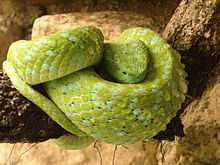Bothriechis bicolor
| Bothriechis bicolor | |
|---|---|
 | |
| Conservation status | |
| Scientific classification | |
| Kingdom: | Animalia |
| Phylum: | Chordata |
| Subphylum: | Vertebrata |
| Class: | Reptilia |
| Order: | Squamata |
| Suborder: | Serpentes |
| Family: | Viperidae |
| Subfamily: | Crotalinae |
| Genus: | Bothriechis |
| Species: | B. bicolor |
| Binomial name | |
| Bothriechis bicolor (Bocourt, 1868) | |
 | |
| Synonyms | |
| |
Bothriechis bicolor is a venomous pit viper species found in southern Mexico, Guatemala and Honduras.[1] The specific name refers to the contrasting ventral and dorsal colors.[3] No subspecies are currently recognized.[5]
Description
Adults are usually 60–70 centimetres (24–28 in) in length, but may reach 100 centimetres (39 in), and the body is relatively slender.[3]
The color pattern consists of a green or bluish green ground color. Usually this is without any pattern, but sometimes specimens from Mexico have black flecks and dots and/or blue blotches. The dorsum of the head is a uniform green without any postocular stripe. The interstitial skin is often blue, which can also be true for the borders of some scales. The belly has a somewhat lighter color, usually a uniform yellowish-green.[3]
Geographic range
Found along the Pacific versant from southeastern Chiapas in Mexico, east to south-central Guatemala. Also known from a few locations in Honduras in the southern part of the Sierra del Merendón and the Cerro Santa Bárbara. The type locality given is "Des forêts de Saint-Augustine, département de Solola (Guatémala), sur le versant occidental de la Cordillèra. 610 mètres d'altitude" [= Forests of St. [San] Augustín, on western slope of the Cordillera, Department of Sololá, Guatemala, 610 m]. Actually, San Augustín is on the southern slope of Volcán Atitlán.[2]
Habitat
Prefers rain forests and cloud forests between 500 metres (1,600 ft) and 2,000 metres (6,600 ft) elevation.[2]
Conservation status
This species is classified as Least Concern (LC) on the IUCN Red List of Threatened Species (v3.1, 2001).[1] Species are listed as such due to their wide distribution, presumed large population, or because it is unlikely to be declining fast enough to qualify for listing in a more threatened category. The population trend is stable. Year assessed: 2007.[1]
See also
- List of crotaline species and subspecies
- Crotalinae by common name
- Crotalinae by taxonomic synonyms
- Snakebite
References
- ↑ 1.0 1.1 1.2 1.3 Campbell, J.A. & Muñoz-Alonso, A. (2007). "Bothriechis bicolor". IUCN Red List of Threatened Species. Version 2011.1. International Union for Conservation of Nature. Retrieved 29 February 2012.
- ↑ 2.0 2.1 2.2 McDiarmid RW, Campbell JA, Touré T. 1999. Snake Species of the World: A Taxonomic and Geographic Reference, vol. 1. Herpetologists' League. 511 pp. ISBN 1-893777-00-6 (series). ISBN 1-893777-01-4 (volume).
- ↑ 3.0 3.1 3.2 3.3 Campbell JA, Lamar WW. 2004. The Venomous Reptiles of the Western Hemisphere. 2 volumes. Comstock Publishing Associates, Ithaca and London. 870 pp. 1500 plates. ISBN 0-8014-4141-2.
- ↑ Mehrtens JM. 1987. Living Snakes of the World in Color. New York: Sterling Publishers. 480 pp. ISBN 0-8069-6460-X.
- ↑ "Bothriechis bicolor". Integrated Taxonomic Information System. Retrieved 8 September 2007.
External links
- Bothriechis bicolor at the Reptarium.cz Reptile Database. Accessed 8 September 2007.
- Bothriechis bicolor at Greg Lasley Nature Photography. Accessed 8 September 2007.
| ||||||
